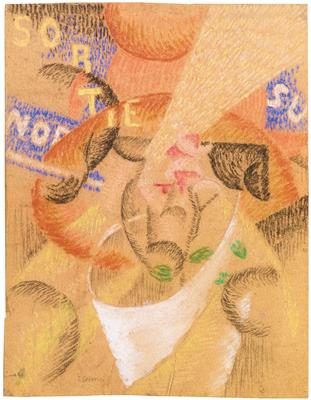Gino Severini *

(Cortona/Arezzo 1883–1966 Paris)
Sortie Nord - Sud, 1913ca., signed G. Severini, gouache, pastel and chalk on brown hard paper laid down on cardboard, 45 x 35 cm, exhibition frame, (AR)
Photo certificate issued by Gina Severini Franchina, Rome 26 June 1974
Photo certificate with the stamp of Archivio Gino Severini, Rome, archive no. 88
We are grateful to Romana Severini Brunori for the information she has kindly provided for this work.
Provenance:
Galerie Zak, Paris
Stephen Mazoh Collection, New York
Earl Leopold Stendhal Collection (1888-1966), Hollywood
Kaufmann Collection, California
sale Christie‘s, New York, 7 November 1979, Lot 26
Galleria La Medusa, Rome;
M. Knoedler & Co., Inc, New York (label on the reverse)
Molina Collection, Pavia
Private Collection, Milan
Galleria Fonte D‘Abisso, Milan
European Private Collection
Exhibition:
Christies´s, Impressionist and Modern Drawings and Watercolors, New York, 7 November 1979, lot 26 with ill. Milan, Galleria Fonte D’Abisso, Archivi futuristi, 7 April - 14 July 1990, exh. cat. pp. 165, 186 no. 135 with ill. (label on the reverse)
Naples, Palazzo Reale, 18 July - 31 October 1996, Futurismo e meridione, exh. cat., p. 165, no. A. 1.5, with ill.
Milan Fondazione Stellline, Wunderkammer. Meraviglie d’arte in una stanza moderna June - July 1999, exh. cat. no. 63 with ill. Literature:
Daniela Fonti, Gino Severini. Catalogo ragionato, Mondadori, Milan 1988, p. 155, no.159 with ill.
Futurism was an exquisitely Italian phenomenon that began as a literary movement in 1909 — thanks to the poet Filippo Marinetti — and then became the very first national artistic avant-garde.
That was a period of great changes, where the swift transformations of society, culture and art were triggered by major factors such as the world wars, scientific progress and technological advances, from which typical Futurist principles like simultaneity, interpenetration and dynamism were directly derived. In such a world, where young people had to choose between the “old” and the “new”, Futurists decided to fight the past and put forward the idea of a dynamic and modern present, strengthened by a fresh and positivistic faith in progress. Marinetti clearly created Futurism as the Italian answer to the French artistic experience and it was probably for this reason that, in 1909, he published the Manifesto del Futurismo in the Parisian newspaper, Le Figaro (whilst the group’s first important exhibition was held in Paris at the Bernheim-Jeune Gallery in 1912).
It was a result of Marinetti’s extraordinary tenacity and resources that the movement found such great success. A year later he gathered five great artists to sign the Manifesto della Pittura Futurista, proclaiming ideas such as the abolition of the traditional perspective of Alberti and Brunelleschi in favour of a new vision based on the simultaneity of different points of view. The aim was to counter ancient and static art with a new dynamic way of painting that could convey the sense of movement and speed, and put the observer inside it.
The Dorotheum is pleased to auction a beautiful Futurist artwork of such an outstanding painter as Gino Severini.
A pupil of Giacomo Balla, Severini was certainly more sensitive and less prone to confusion and provocation than his colleagues. He began his painting career in 1900 and in 1906 moved to Paris, where he came in contact with leading members of the French avant-garde, such as Dufy, Valadon and his son, Utrillo, the Cubist painters Braque and Pablo Picasso and the writer Guillaume Apollinaire.
He was deeply influenced by the pointillisme style (a technique that entails applying dots of contrasting colours according to principles of optical science), and continued to use it in his own personal approach by combining it with the Futurist grammar.
Although at that time he claimed to be closer to his French colleagues, he actually shared a theme with Marinetti’s group in 1912 and 1913: the vertigo of speed. Over a period of a few months he worked on a series of paintings and drawings that introduced a new – simultaneous and accelerated – vision of the city, which was then portrayed in the chaos of buses, trams, signs and advertising posters.
All this is also visible in the present work, Sortie Nord – Sud from around 1913, where what looks like beams of light merges with the movement of dynamic shapes and a fleeting glimpse of the words Sortie, Nord and Sud, clearly inspired by Paris metro stations.
Furthermore, as in most of his works, there is the evident intention of representing motion and dynamism, which are achieved perfectly but in a mild and more lyrical manner. It is clear how a deeper exchange with French avant-gardes led him to a recognisable style characterised by a more joyful and happy colour palette and a dynamic yet not violent composition.
From an important Private Collection
Specialist: Alessandro Rizzi
 Alessandro Rizzi
Alessandro Rizzi
+39-02-303 52 41
alessandro.rizzi@dorotheum.it
24.11.2015 - 18:00
- Realized price: **
-
EUR 369,000.-
- Estimate:
-
EUR 300,000.- to EUR 400,000.-
Gino Severini *
(Cortona/Arezzo 1883–1966 Paris)
Sortie Nord - Sud, 1913ca., signed G. Severini, gouache, pastel and chalk on brown hard paper laid down on cardboard, 45 x 35 cm, exhibition frame, (AR)
Photo certificate issued by Gina Severini Franchina, Rome 26 June 1974
Photo certificate with the stamp of Archivio Gino Severini, Rome, archive no. 88
We are grateful to Romana Severini Brunori for the information she has kindly provided for this work.
Provenance:
Galerie Zak, Paris
Stephen Mazoh Collection, New York
Earl Leopold Stendhal Collection (1888-1966), Hollywood
Kaufmann Collection, California
sale Christie‘s, New York, 7 November 1979, Lot 26
Galleria La Medusa, Rome;
M. Knoedler & Co., Inc, New York (label on the reverse)
Molina Collection, Pavia
Private Collection, Milan
Galleria Fonte D‘Abisso, Milan
European Private Collection
Exhibition:
Christies´s, Impressionist and Modern Drawings and Watercolors, New York, 7 November 1979, lot 26 with ill. Milan, Galleria Fonte D’Abisso, Archivi futuristi, 7 April - 14 July 1990, exh. cat. pp. 165, 186 no. 135 with ill. (label on the reverse)
Naples, Palazzo Reale, 18 July - 31 October 1996, Futurismo e meridione, exh. cat., p. 165, no. A. 1.5, with ill.
Milan Fondazione Stellline, Wunderkammer. Meraviglie d’arte in una stanza moderna June - July 1999, exh. cat. no. 63 with ill. Literature:
Daniela Fonti, Gino Severini. Catalogo ragionato, Mondadori, Milan 1988, p. 155, no.159 with ill.
Futurism was an exquisitely Italian phenomenon that began as a literary movement in 1909 — thanks to the poet Filippo Marinetti — and then became the very first national artistic avant-garde.
That was a period of great changes, where the swift transformations of society, culture and art were triggered by major factors such as the world wars, scientific progress and technological advances, from which typical Futurist principles like simultaneity, interpenetration and dynamism were directly derived. In such a world, where young people had to choose between the “old” and the “new”, Futurists decided to fight the past and put forward the idea of a dynamic and modern present, strengthened by a fresh and positivistic faith in progress. Marinetti clearly created Futurism as the Italian answer to the French artistic experience and it was probably for this reason that, in 1909, he published the Manifesto del Futurismo in the Parisian newspaper, Le Figaro (whilst the group’s first important exhibition was held in Paris at the Bernheim-Jeune Gallery in 1912).
It was a result of Marinetti’s extraordinary tenacity and resources that the movement found such great success. A year later he gathered five great artists to sign the Manifesto della Pittura Futurista, proclaiming ideas such as the abolition of the traditional perspective of Alberti and Brunelleschi in favour of a new vision based on the simultaneity of different points of view. The aim was to counter ancient and static art with a new dynamic way of painting that could convey the sense of movement and speed, and put the observer inside it.
The Dorotheum is pleased to auction a beautiful Futurist artwork of such an outstanding painter as Gino Severini.
A pupil of Giacomo Balla, Severini was certainly more sensitive and less prone to confusion and provocation than his colleagues. He began his painting career in 1900 and in 1906 moved to Paris, where he came in contact with leading members of the French avant-garde, such as Dufy, Valadon and his son, Utrillo, the Cubist painters Braque and Pablo Picasso and the writer Guillaume Apollinaire.
He was deeply influenced by the pointillisme style (a technique that entails applying dots of contrasting colours according to principles of optical science), and continued to use it in his own personal approach by combining it with the Futurist grammar.
Although at that time he claimed to be closer to his French colleagues, he actually shared a theme with Marinetti’s group in 1912 and 1913: the vertigo of speed. Over a period of a few months he worked on a series of paintings and drawings that introduced a new – simultaneous and accelerated – vision of the city, which was then portrayed in the chaos of buses, trams, signs and advertising posters.
All this is also visible in the present work, Sortie Nord – Sud from around 1913, where what looks like beams of light merges with the movement of dynamic shapes and a fleeting glimpse of the words Sortie, Nord and Sud, clearly inspired by Paris metro stations.
Furthermore, as in most of his works, there is the evident intention of representing motion and dynamism, which are achieved perfectly but in a mild and more lyrical manner. It is clear how a deeper exchange with French avant-gardes led him to a recognisable style characterised by a more joyful and happy colour palette and a dynamic yet not violent composition.
From an important Private Collection
Specialist: Alessandro Rizzi
 Alessandro Rizzi
Alessandro Rizzi
+39-02-303 52 41
alessandro.rizzi@dorotheum.it
|
Buyers hotline
Mon.-Fri.: 10.00am - 5.00pm
kundendienst@dorotheum.at +43 1 515 60 200 |
| Auction: | Modern Art |
| Auction type: | Saleroom auction |
| Date: | 24.11.2015 - 18:00 |
| Location: | Vienna | Palais Dorotheum |
| Exhibition: | 14.11. - 24.11.2015 |
** Purchase price incl. buyer's premium and VAT
It is not possible to turn in online buying orders anymore. The auction is in preparation or has been executed already.
